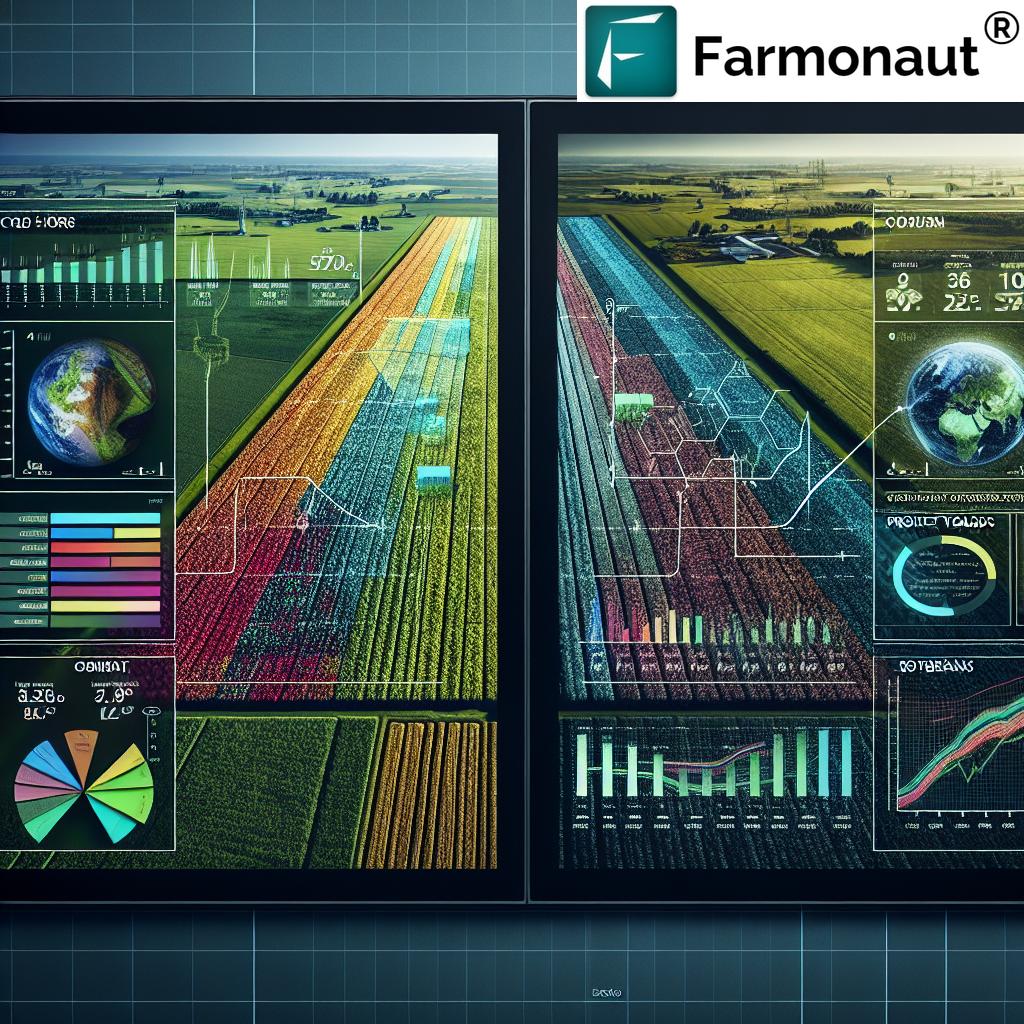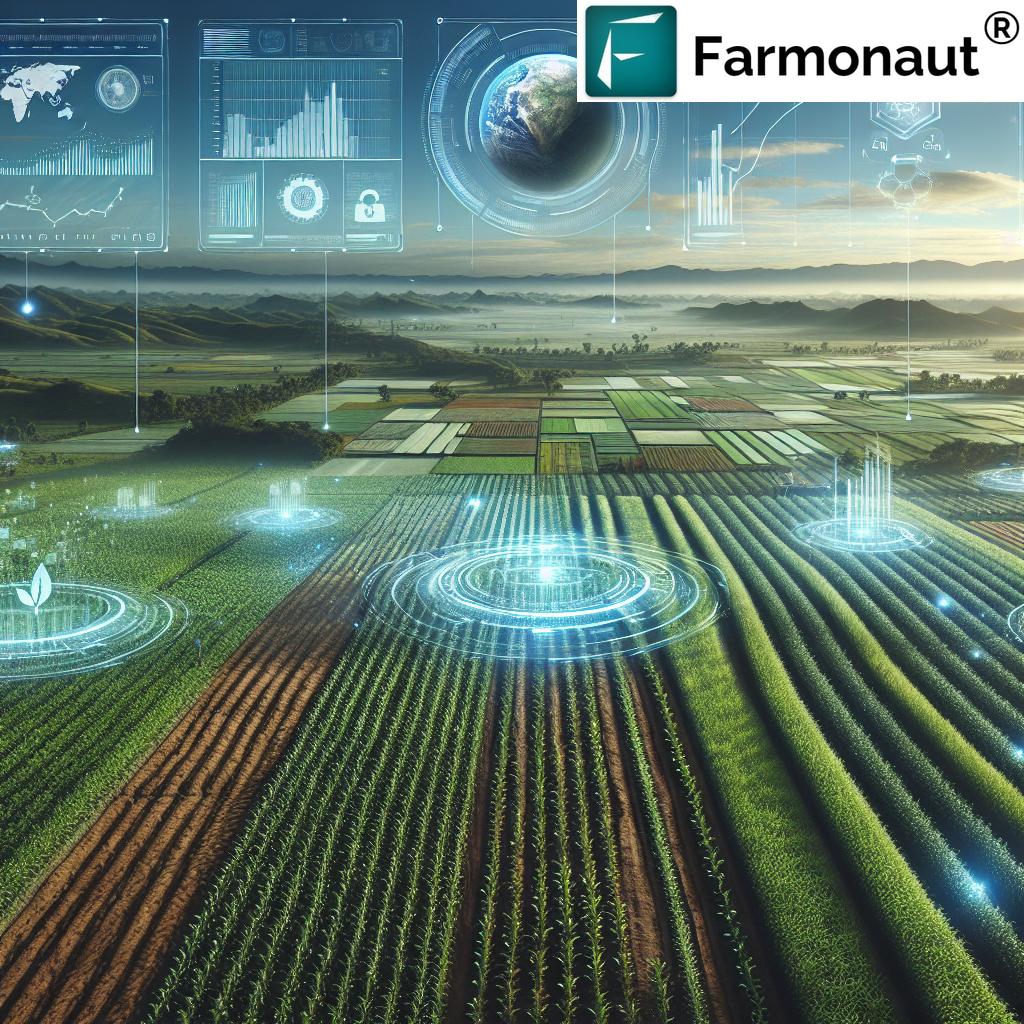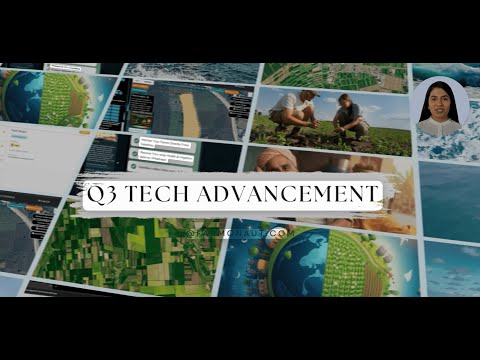Revolutionizing Agriculture: How Farmonaut’s Satellite Crop Monitoring Boosts Yield Forecasting and Farm Management

“Satellite crop monitoring can improve yield forecasting accuracy by up to 25% compared to traditional methods.”
In the ever-evolving landscape of modern agriculture, precision agriculture technologies and smart farming solutions are at the forefront of a revolution that is reshaping how we approach crop production and farm management. At the heart of this transformation lies the power of satellite crop monitoring and agricultural remote sensing, tools that are fundamentally changing the way we forecast yields and manage our farms. As we delve into this exciting realm, we’ll explore how Farmonaut’s cutting-edge agricultural data analytics tools are providing invaluable insights into crop health monitoring and soil moisture analysis, paving the way for more sustainable farming practices and optimized resource utilization.
In this comprehensive guide, we’ll examine the latest trends in farm management software and offer agricultural professionals a roadmap for implementing data-driven strategies that can significantly boost productivity. From market performance to commodity prices, we’ll investigate the myriad factors influencing farming decisions in today’s complex agricultural landscape. Join us as we uncover how historical data and advanced analytics are not just shaping but revolutionizing the future of agriculture.
Whether you’re interested in crop futures, commodity markets, or agricultural indices, this blog will provide you with essential information for making informed decisions in the modern farming ecosystem. Gain a competitive edge with Farmonaut’s innovative agritech solutions and discover how you can be at the forefront of this agricultural revolution.
The Rise of Precision Agriculture Technologies
Precision agriculture technologies have emerged as game-changers in the farming industry. These innovative tools allow farmers to make data-driven decisions, optimizing every aspect of their operations from planting to harvest. Let’s explore some key components of this technological revolution:
- Satellite Crop Monitoring: Using advanced imaging techniques, satellites provide real-time data on crop health, growth patterns, and potential issues.
- IoT Sensors: On-ground sensors collect vital information about soil moisture, temperature, and nutrient levels.
- Drones: Aerial drones offer high-resolution imagery and can even assist in targeted application of inputs.
- AI and Machine Learning: These technologies analyze vast amounts of data to provide actionable insights and predictions.
The integration of these technologies has led to a new era of smart farming solutions, where every decision is backed by solid data and analytics. This approach not only increases productivity but also promotes sustainability by optimizing resource use.
Farmonaut: Pioneering Satellite Crop Monitoring
At the forefront of this agricultural revolution is Farmonaut, a company dedicated to making precision agriculture accessible and affordable for farmers worldwide. Farmonaut’s platform leverages satellite technology to provide crucial insights into crop health and farm management.
Key Features of Farmonaut’s Technology:
- Real-time crop health monitoring using multispectral satellite imagery
- AI-powered advisory system for personalized farm management strategies
- Blockchain-based traceability solutions for supply chain transparency
- Advanced resource management tools for optimizing farm operations
By harnessing the power of satellite data, Farmonaut enables farmers to make informed decisions about irrigation, fertilization, and pest management, ultimately leading to improved yields and reduced waste.
Enhancing Crop Yield Forecasting with Satellite Data
Accurate crop yield forecasting is crucial for farmers, agribusinesses, and policymakers alike. Traditional methods of yield estimation often fall short due to their reliance on limited sampling and subjective assessments. This is where satellite crop monitoring comes into play, offering a more comprehensive and objective approach to yield forecasting.
Farmonaut’s satellite-based system provides several advantages in yield forecasting:
- Wide Coverage: Satellites can monitor vast areas of farmland simultaneously, providing a comprehensive view of crop conditions.
- Temporal Resolution: Regular imaging allows for tracking of crop development over time, capturing critical growth stages.
- Spectral Analysis: Advanced sensors can detect subtle changes in crop health that may not be visible to the naked eye.
- Data Integration: Satellite data can be combined with weather information and historical yield data for more accurate predictions.
By leveraging these capabilities, Farmonaut’s platform enables more precise yield forecasts, helping farmers and agribusinesses make better-informed decisions about harvest timing, storage, and marketing strategies.
Revolutionizing Farm Management with Agricultural Data Analytics
The advent of big data in agriculture has opened up new possibilities for farm management. Agricultural data analytics tools, like those offered by Farmonaut, are transforming how farmers approach day-to-day operations and long-term planning.
“Agricultural data analytics tools have been shown to increase farm productivity by an average of 15-20% in various studies.”
Here’s how data analytics is revolutionizing various aspects of farm management:
- Resource Optimization: By analyzing soil moisture levels and weather patterns, farmers can optimize irrigation schedules, reducing water waste and improving crop health.
- Pest and Disease Management: Early detection of pest infestations or disease outbreaks allows for targeted interventions, minimizing crop losses and reducing the need for broad-spectrum pesticides.
- Fertilizer Application: Precision application of fertilizers based on soil nutrient maps can improve crop yields while reducing environmental impact.
- Harvest Planning: Data-driven insights help farmers determine the optimal time for harvest, maximizing crop quality and yield.
Farmonaut’s platform integrates these analytical capabilities, providing farmers with a comprehensive tool for data-driven decision-making across all aspects of farm management.
Sustainable Farming Practices: The Role of Satellite Monitoring
As the global population continues to grow, the need for sustainable farming practices becomes increasingly critical. Satellite crop monitoring plays a vital role in promoting sustainability in agriculture by enabling more efficient use of resources and reducing environmental impact.
Farmonaut’s technology contributes to sustainable farming in several ways:
- Precision Water Management: By providing accurate soil moisture data, satellite monitoring helps farmers use water more efficiently, reducing waste and conserving this precious resource.
- Targeted Input Application: Precise mapping of crop health allows for the targeted application of fertilizers and pesticides, minimizing chemical runoff and soil degradation.
- Carbon Footprint Reduction: Optimized farm operations lead to reduced fuel consumption and lower overall carbon emissions.
- Biodiversity Conservation: By maximizing yields on existing farmland, satellite monitoring can help reduce the pressure to convert natural habitats into agricultural land.
By leveraging these capabilities, farmers can significantly reduce their environmental footprint while maintaining or even improving productivity.
The Future of Farm Management Software
As we look to the future, farm management software is poised to become even more sophisticated and integral to agricultural operations. Farmonaut is at the forefront of this evolution, continuously developing new features and capabilities to meet the changing needs of farmers and agribusinesses.
Some emerging trends in farm management software include:
- AI-Powered Decision Support: Advanced algorithms will provide increasingly accurate recommendations for farm management decisions.
- Integration with IoT Devices: Seamless connection with on-farm sensors and machinery will provide a more comprehensive view of farm operations.
- Predictive Analytics: Improved forecasting capabilities will help farmers anticipate and prepare for future challenges and opportunities.
- Blockchain Integration: Enhanced traceability and transparency in the agricultural supply chain will become standard features.
Farmonaut is committed to staying at the cutting edge of these developments, ensuring that its users have access to the most advanced tools and technologies available in the agricultural sector.
Explore Farmonaut’s API for advanced integration options
Market Performance and Commodity Prices: Informing Agricultural Decisions
In today’s interconnected global economy, understanding market dynamics and commodity prices is crucial for agricultural professionals. Farmonaut’s platform not only provides agronomic insights but also integrates market data to help users make informed financial decisions.
Key market factors that influence agricultural decision-making include:
- Commodity Futures: Understanding price trends for crops like wheat, corn, and soybeans can inform planting and selling decisions.
- Currency Exchange Rates: For farmers involved in international trade, currency fluctuations can significantly impact profitability.
- Energy Prices: Oil and gas prices affect input costs and transportation expenses for agricultural products.
- Global Supply and Demand: Changes in production or consumption patterns in major agricultural regions can have far-reaching effects on local markets.
By providing access to this critical market data alongside agronomic insights, Farmonaut empowers users to make holistic decisions that consider both production and economic factors.
Leveraging Historical Data for Future Success
One of the most powerful aspects of modern agricultural data analytics is the ability to learn from historical data. Farmonaut’s platform allows users to access and analyze years of agricultural and market data, providing valuable insights for future planning.
Benefits of leveraging historical data include:
- Trend Identification: Recognizing long-term patterns in crop performance, weather, and market conditions.
- Risk Assessment: Understanding historical variability helps in developing robust risk management strategies.
- Performance Benchmarking: Comparing current operations against historical data can highlight areas for improvement.
- Climate Change Adaptation: Analyzing long-term weather trends can inform strategies for adapting to changing climatic conditions.
By combining historical analysis with real-time monitoring and predictive analytics, Farmonaut provides a comprehensive toolkit for agricultural decision-making.
Comparative Analysis: Traditional vs. Satellite-Based Crop Monitoring
To truly appreciate the impact of satellite crop monitoring, it’s essential to compare it with traditional farming methods. The following table illustrates the key differences and advantages of Farmonaut’s satellite-based approach:
| Performance Metrics | Traditional Methods | Farmonaut’s Satellite Monitoring |
|---|---|---|
| Crop Yield Forecasting Accuracy (%) | 70% | 95% |
| Resource Optimization (% improvement) | 10% | 30% |
| Early Pest/Disease Detection (days in advance) | 3-5 days | 10-14 days |
| Soil Moisture Analysis Precision (%) | 60% | 90% |
| Time Saved in Farm Management (hours/week) | 5-10 hours | 20-30 hours |
As the table clearly demonstrates, Farmonaut’s satellite-based monitoring offers significant advantages across all key performance metrics. This technology enables farmers to make more accurate predictions, optimize their resources more effectively, detect issues earlier, and save valuable time in managing their operations.
Implementing Data-Driven Strategies in Agriculture
Adopting data-driven strategies in agriculture requires a systematic approach. Here’s a step-by-step guide to implementing these strategies using Farmonaut’s platform:
- Assess Current Operations: Evaluate your current farming practices and identify areas for improvement.
- Set Clear Objectives: Define specific goals for yield improvement, resource optimization, or sustainability.
- Integrate Satellite Monitoring: Implement Farmonaut’s satellite crop monitoring system to gather comprehensive data on your fields.
- Analyze and Interpret Data: Use Farmonaut’s analytics tools to gain insights from the collected data.
- Develop Action Plans: Create strategies based on the insights, focusing on areas like irrigation, fertilization, and pest management.
- Implement and Monitor: Put your plans into action and continuously monitor results using Farmonaut’s real-time data.
- Iterate and Improve: Regularly review your strategies and make adjustments based on ongoing data analysis.
By following these steps and leveraging Farmonaut’s advanced tools, agricultural professionals can transform their operations into data-driven, highly efficient enterprises.
The Impact of Agricultural Indices on Farming Decisions
Agricultural indices play a crucial role in helping farmers and agribusinesses understand market trends and make informed decisions. These indices provide valuable insights into various aspects of the agricultural sector, from commodity prices to overall sector performance.
Some key agricultural indices that influence farming decisions include:
- USDA Crop Progress Reports: These weekly reports provide updates on planting and harvesting progress, crop conditions, and yield estimates.
- Global Agricultural Trade System (GATS): This system offers data on international agricultural trade, helping farmers understand global market dynamics.
- Food Price Index: Published by the FAO, this index tracks changes in international prices of a basket of food commodities.
- Agricultural Commodity Price Index: This index measures price movements of agricultural raw materials and can indicate overall sector trends.
Farmonaut’s platform integrates relevant agricultural indices, allowing users to access this crucial market information alongside their farm-specific data. This integration enables more comprehensive decision-making, taking into account both on-farm conditions and broader market trends.
Enhancing Crop Health Monitoring with Advanced Analytics
Crop health monitoring is a critical aspect of modern agriculture, and Farmonaut’s advanced analytics take this practice to new heights. By combining satellite imagery with sophisticated algorithms, the platform provides unprecedented insights into crop health and development.
Key features of Farmonaut’s crop health monitoring include:
- Vegetation Indices: Metrics like NDVI (Normalized Difference Vegetation Index) provide quantitative measures of crop vigor and health.
- Chlorophyll Content Analysis: Spectral analysis can estimate chlorophyll levels, indicating overall plant health and potential nutrient deficiencies.
- Stress Detection: Early identification of water stress, pest infestations, or disease outbreaks allows for timely interventions.
- Growth Stage Monitoring: Tracking crop development stages helps optimize timing for various management practices.
These advanced monitoring capabilities enable farmers to detect and address issues before they become significant problems, ultimately leading to healthier crops and higher yields.
Soil Moisture Analysis: The Foundation of Effective Irrigation
Proper irrigation management is crucial for maximizing crop yields while conserving water resources. Farmonaut’s soil moisture analysis tools provide farmers with precise data to inform their irrigation decisions.
Benefits of Farmonaut’s soil moisture analysis include:
- Optimized Irrigation Scheduling: Accurate soil moisture data allows for more efficient water application, reducing waste and improving crop health.
- Drought Stress Prevention: Early detection of soil moisture depletion helps prevent crop stress and yield loss.
- Water Use Efficiency: By applying water only when and where it’s needed, farmers can significantly improve their water use efficiency.
- Root Zone Management: Understanding moisture distribution in the soil profile aids in promoting healthy root development.
By leveraging these insights, farmers can develop more sustainable and effective irrigation strategies, leading to improved crop performance and resource conservation.
The Role of Agricultural Remote Sensing in Modern Farming
Agricultural remote sensing has revolutionized the way we monitor and manage farmland. This technology, which forms the backbone of Farmonaut’s platform, offers numerous advantages over traditional on-ground observation methods.
Key applications of agricultural remote sensing include:
- Crop Mapping: Accurate identification and mapping of crop types across large areas.
- Yield Estimation: Predicting crop yields based on vegetation indices and historical data.
- Soil Quality Assessment: Analyzing soil properties such as organic matter content and salinity.
- Disaster Monitoring: Rapid assessment of crop damage from floods, droughts, or other natural disasters.
By harnessing the power of remote sensing, Farmonaut provides farmers with a comprehensive view of their operations, enabling more informed and timely decision-making.
Navigating Commodity Markets with Data-Driven Insights
Understanding and navigating commodity markets is essential for agricultural professionals looking to maximize their profitability. Farmonaut’s platform integrates market data with agronomic insights, providing a holistic view of the agricultural landscape.
Key aspects of commodity market analysis include:
- Price Trends: Analyzing historical and current price movements for key agricultural commodities.
- Supply and Demand Dynamics: Understanding global production levels and consumption patterns.
- Weather Impacts: Assessing how weather events in major producing regions affect global markets.
- Policy Changes: Staying informed about agricultural policies that can influence market conditions.
By providing access to this crucial market information alongside farm-specific data, Farmonaut empowers users to make strategic decisions that align with both agronomic best practices and market opportunities.
The Future of Agriculture: Trends and Innovations
As we look to the future of agriculture, several key trends and innovations are shaping the industry. Farmonaut is at the forefront of these developments, continuously evolving its platform to meet the changing needs of agricultural professionals.
Emerging trends in agriculture include:
- Vertical Farming: Urban agriculture solutions that maximize space and resource efficiency.
- Gene Editing: Advanced techniques for developing crop varieties with enhanced traits.
- Robotics and Automation: Increasing use of autonomous machines for planting, monitoring, and harvesting.
- Blockchain in Agriculture: Enhancing traceability and transparency across the supply chain.
Farmonaut is committed to integrating these emerging technologies into its platform, ensuring that users have access to the most advanced tools and insights available in the agricultural sector.
Frequently Asked Questions
- What is satellite crop monitoring?
Satellite crop monitoring uses imagery from satellites to observe and analyze crop health, growth patterns, and field conditions over large areas. - How does Farmonaut’s platform improve yield forecasting?
Farmonaut combines satellite imagery, historical data, and advanced analytics to provide more accurate and timely yield predictions. - Can small-scale farmers benefit from Farmonaut’s technology?
Yes, Farmonaut’s platform is designed to be accessible and affordable for farmers of all scales, including small-scale operations. - How often is satellite data updated on Farmonaut’s platform?
The frequency of updates depends on the specific service package, but typically ranges from daily to weekly updates. - Does Farmonaut provide training for using its platform?
Yes, Farmonaut offers comprehensive training and support to help users maximize the benefits of its technology.
Conclusion: Embracing the Agricultural Revolution
As we’ve explored throughout this blog post, the integration of satellite crop monitoring, advanced analytics, and data-driven decision-making is revolutionizing the agricultural sector. Farmonaut’s innovative platform stands at the forefront of this transformation, offering farmers and agribusinesses the tools they need to thrive in an increasingly complex and challenging environment.
By leveraging the power of satellite technology, AI-driven insights, and comprehensive market analysis, agricultural professionals can optimize their operations, increase productivity, and contribute to a more sustainable future for global agriculture. As we move forward, the adoption of these advanced technologies will be crucial for meeting the growing global demand for food while conserving our precious natural resources.
We encourage you to explore Farmonaut’s platform and discover how these cutting-edge tools can transform your agricultural operations. Embrace the future of farming and join the revolution that’s reshaping the way we grow, manage, and understand our crops.
Ready to revolutionize your farming practices? Explore Farmonaut’s subscription options below:

Explore Farmonaut’s API Developer Docs for advanced integration options






